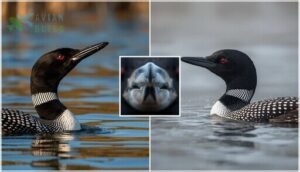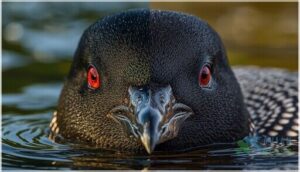This site is supported by our readers. We may earn a commission, at no cost to you, if you purchase through links.

You’ve probably heard a common loon before you’ve seen one. That haunting, yodel-like wail echoing across a northern lake at dusk isn’t just atmospheric—it’s one of nature’s most recognizable soundtracks, older than the lakes themselves.
These birds carry 35 million years of evolutionary fine-tuning in their bones, literally. Every detail of their design fulfills a singular purpose: mastering the underwater world where they spend most of their lives hunting fish.
But despite their ancient lineage and iconic status, common loons face mounting pressures that have quietly eroded their numbers by 14% in less than two decades. Understanding what makes these birds so uniquely adapted to their environment helps explain why they’re increasingly vulnerable to changes in it.
Table Of Contents
Key Takeaways
- Common loons have evolved for 35 million years into specialized underwater hunters, but their population has dropped 14% since 2005 due to mercury contamination, shoreline development, and habitat loss that threatens their clear-water lake requirements.
- These birds don’t actually mate for life—they’re serially monogamous and stay with partners for about six to seven years, but they show fierce loyalty to their breeding territories, often returning to the same nesting sites year after year.
- Climate change projections suggest an 80% loss of U.S. breeding habitat by 2050, yet Vermont’s recovery from 7 to 115 nesting pairs proves that targeted conservation efforts like artificial nesting platforms and shoreline buffers can reverse population declines.
- Loons’ extreme physical adaptations for diving—legs positioned far back, dense bones, and bodies built for water—make them masters underwater but nearly helpless on land, requiring long water runways just to take off.
Common Loon Taxonomy and Classification
If you want to understand the common loon’s place in the natural world, you need to know where it fits in the scientific order of things. Scientists have given this bird a formal classification that tells you exactly what it is and how it relates to other species.
You’ll also see how conservation groups track it and what its current status means for its survival.
Scientific Classification (Order, Family, Genus, Species)
You’ll find the common loon sitting at the top of an ancient bird taxonomy. Its binomial nomenclature—Gavia immer—places it within order Gaviiformes and family Gaviidae. This phylogenetic analysis reveals it’s the sole Gavia genus member in North America, representing one of Earth’s oldest bird lineages.
Classification systems track this species through 35 million years of fossil records, making species identification part of understanding deep evolutionary history.
The common loon’s conservation status is influenced by its loon natural history and habitat requirements.
Identification by Conservation Organizations
You can spot a common loon through visual cues like its dagger-shaped bill, rounded head, and low-slung profile. Conservation groups rely on acoustic markers—those haunting yodels and wails—plus field guides and taxonomy references to confirm bird identification.
These identification protocols combine what you see and hear, helping organizations track common loon identification for species assessment and conservation status monitoring beyond just IUCN Red List categories. Common Loons establish their nesting territory through distinctive yodeling songs.
IUCN Red List Status and Criteria
You’ll find the common loon listed as Least Concern on the IUCN Red List since 1998—thanks to its broad range and stable population assessment of 612,000 to 640,000 birds. Red List criteria focus on population decline rates and threat evaluation across regional variations.
While conservation measures protect breeding sites from shoreline development and mercury contamination, threat assessment reveals localized challenges despite overall conservation status remaining secure.
Physical Characteristics of The Common Loon
When you spot a common loon on the water, you’re looking at a bird built for a life between two worlds. Their physical traits reveal how they’ve adapted to thrive in aquatic environments while still maintaining the ability to fly.
Here’s what sets these striking birds apart from other waterbirds you might encounter.
Body Shape and Size
You’ll recognize a common loon by its hydrodynamic bodies and unique body proportions—nature built them for the water, not the shore. Adults measure 66 to 92 cm in length with a wingspan stretching 104 to 147 cm, though size variations exist across regions.
Key measurements and diving adaptations include:
- Weight ranges from 1.6 to 8.0 kg, with males up to 27% heavier
- Dense bones reduce buoyancy for deeper dives
- Legs positioned far back improve propulsion underwater
- Large webbed feet power fast underwater chases
- Low-profile body shape minimizes water resistance
Their size and shape reflect pure function—every feature aids their aquatic lifestyle.
Feather Coloration and Seasonal Plumage
Common loons wear two seasonal coats that shift with their travels. Breeding plumage brings black and white patterns—a stunning checkerboard back adorned with iridescent sheens and bold white “necklaces” against an ebony head.
Come winter, they swap this tuxedo for gray plumage above and white below, creating color camouflage suited for coastal waters. Feather molting between seasons maintains their waterproof armor for diving.
Beak Shape and Color
You’ll spot the loon’s dagger-like bill—straight, heavy, and unmistakable in its purpose. This tool shifts appearance with the seasons, a visual cue to the bird’s life cycle.
- Breeding adults sport glossy black bills from May through July
- Winter birds shift to pale bluish-gray or horn-colored beaks
- Juveniles carry dull gray bills until their second year
- Rear-pointing projections inside grip slippery fish during underwater hunts
Eye Color
The iris holds a secret about breeding readiness—watch for that striking red glow during nesting season. Adult loons flash bright red irises from spring through summer, a vivid marker you won’t miss on the water.
Come winter, eye coloration fades to duller brown or maroon tones. This iris pigmentation shift isn’t just for show; it’s a reliable age indicator, since juveniles carry drab gray-brown eyes until maturity hits around their second or third year.
Leg and Foot Structure
Loons trade land mobility for underwater mastery—their legs sit so far back they can barely shuffle on shore. Those massive webbed feet, spanning over 15 cm in adults, generate powerful thrust during dives that reach 61 meters deep.
You’ll notice enlarged leg muscles and dense bones that reduce buoyancy, making them champion divers. This rear-leg placement means they need long water runways for takeoff.
Habitat, Range, and Migration
Common loons aren’t locked into one territory year-round—they move with the seasons, following the water that sustains them. You’ll find them in wildly different places depending on whether it’s summer or winter, and the quality of their habitat directly affects their survival.
Let’s look at where these birds spend their time and how they navigate the shifting landscape of North America.
Breeding and Wintering Grounds
You’ll find breeding loons scattered across a vast northern region, with over 94% nesting in Canada—Ontario alone hosts 97,000 territorial pairs. When winter arrives, these birds abandon their freshwater haunts for coastal waters along both North American coasts. Here’s where they go:
- Pacific Coast: 184,000–189,000 adults wintering
- Atlantic Coast: 423,000–446,000 adults recorded
- Great Lakes region: 5,900–7,200 breeding pairs
- Migration distances: 152–527 km between sites
Habitat loss and human pressure threaten both breeding success and wintering sites.
Distribution Across North America
You’re looking at a bird whose range tells a story of retreat and resilience. Common loons now breed across 28 U.S. states and all 10 Canadian provinces, with their stronghold in boreal lake habitat—Ontario and Quebec hold nearly 150,000 territorial pairs.
Population shifts reveal habitat loss pushing them northward, away from former southern breeding grounds below the Great Lakes, concentrating in the North Woods lake country where conservation efforts focus today.
Preferred Lake and Water Features
Not every body of water makes the cut for these birds. You’ll find them settling on clear, spacious northern wilderness lakes—usually 60 acres or larger with shorelines stretching beyond what development can swallow.
Loon habitat depends on three non-negotiables:
- Water clarity for hunting fish visually
- Depth requirements exceeding 5 meters for diving pursuits
- Aquatic biodiversity supporting abundant small fish populations
Inland lakes lacking these features stay empty, no matter how wild they look.
Migration Patterns and Routes
Once you understand where loons settle, you’ll want to know how they get there. These birds don’t wander aimlessly—they follow distinct routes with surprising route fidelity. Minnesota and Wisconsin populations split between the Gulf of Mexico and mid-Atlantic coasts, while western Canadian breeders head to the Pacific.
Migration speed impresses: adults cover up to 670 miles in single flights, though juveniles take their time, using stopover ecology strategies across multiple lakes before reaching their wintering range.
Human Impacts on Loon Habitat
While migration brings loons to their destinations, shoreline development threatens what they find when they arrive. Habitat loss from construction reduces nesting sites, and nest disturbance from boating prompts abandonment within 48 hours.
Mercury contamination affects over 50% of eggs in some regions, while poor water clarity cuts chick survival by 30%.
Restoration initiatives now combat these threats, protecting this vulnerable species through habitat acquisition and conservation efforts.
Behavior, Diet, and Vocalizations
When you watch a common loon on the water, you’re seeing one of nature’s most skilled underwater hunters in action. These birds have adapted their entire lifestyle around catching fish, from their powerful diving abilities to their strategic use of clear water habitats.
Understanding how loons feed, interact with each other, and communicate through their haunting calls gives you a fuller picture of what makes them such striking inhabitants of North America’s northern lakes.
Feeding Habits and Hunting Techniques
Common loons are masters of the underwater hunt, transforming from awkward land-dwellers into swift, agile predators beneath the surface. Their feeding behavior revolves around visual prey detection and precision strikes in clear water.
- Dive durations average 40–90 seconds, with loons reaching depths up to 70 meters to pursue fish
- Prey detection begins with “peering”—dipping their heads underwater to scout before committing to a dive
- Hunting efficiency drops dramatically in murky conditions, requiring twice the capture time compared to clear waters
- Social foraging occasionally occurs in winter, with flocks exceeding 600 loons targeting abundant offshore prey
Diet and Prey Selection
Fish make up roughly 80% of what you’ll find in a loon’s belly—yellow perch, sunfish, trout, and pike top the menu in freshwater, while flounder and herring take over in coastal winter grounds. The remaining 20% comes from crayfish, aquatic insects, frogs, and even plant material like pondweed. Loons swallow stones to grind bones, keeping 10–20 in their gizzard at any time.
| Habitat Type | Primary Prey | Supplemental Foods |
|---|---|---|
| Breeding Lakes | Yellow perch, sunfish, trout, bass | Crayfish, aquatic insects, frogs |
| Winter Coasts | Flounder, herring, rockfish, haddock | Marine crustaceans, mollusks |
| Early Development | Minnows, insect larvae | Small crustaceans, leeches |
| Low Fish Availability | Pike, walleye, whitefish | Salamanders, aquatic plants, snails |
| Opportunistic Feeding | Rock bass, gizzard shad | Ducklings, pondweed, algae |
Foraging and Diving Behavior
You’ll watch a loon vanish beneath the surface for nearly two minutes, plunging up to 200 feet to snatch prey from the lake bottom. These underwater divers spend 60% of daylight hours hunting, and their feeding habits reveal striking precision.
- Square dive patterns keep them at maximum depth over half the dive, targeting benthic zones where fish cluster
- Rapid descent and ascent minimize travel time, maximizing energy efficiency during each 104-second plunge
- Repeated dives to consistent depths show calculated prey capture rather than random searching
- Post-dive surface intervals increase with depth, allowing recovery between ambitious foraging strategies
Social Interactions and Territoriality
Loon behavior centers on fierce territorial defense, with breeding pairs controlling 60 to 200 acres throughout the season. Ritualized circle dances occur during low-level encounters, escalating to physical fights if rivals won’t back down.
Social gatherings of 3 to 15 birds take place mid-summer, featuring splash-diving and bill-dipping—possibly serving as courtship displays where loons assess potential mates. Site fidelity is strong; pairs return annually to the same territory.
Loon Calls and Vocal Communication
You’ll hear four distinct loon vocalizations echoing across northern lakes: wails for long-distance contact, tremolos signaling distress, yodels for territorial defense, and soft hoots between family members.
Males use yodeling as acoustic signals to establish dominance—larger males produce lower frequencies that deter rivals. These call variations enable social recognition, with neighbors distinguishing familiar from unfamiliar loons.
Vocal learning shapes loon behavior, especially during nighttime chorus responses when territorial disputes intensify.
Reproduction, Nesting, and Conservation
Common loons build their future one careful nest at a time, returning to the same territories year after year with fierce loyalty.
You’ll find their breeding strategies shaped by both ancient instinct and modern threats—from how they choose their mates to the challenges they face raising chicks in a changing world.
Understanding their reproductive cycle and current conservation status gives you a clearer picture of what these birds need to survive.
Mating Systems and Pair Bonds
You might think loons mate for life, but their reality is more complex. Common loon reproduction follows a serially monogamous system where breeding pairs defend territories together, often reuniting for six to seven years before parental care needs or territorial defense shifts loyalties.
Their avian reproduction strategy prioritizes place over partner—loons show stronger fidelity to breeding territories than to mates, with younger intruders frequently triggering pair bonding changes through territorial challenges.
Nest Placement and Construction
You’ll find loons building their nests right where water meets land—usually on small islands, floating bog mats, or tucked into sheltered bays. Males choose these nest site locations, showing extraordinary fidelity to successful spots they’ll refurbish year after year.
Both parents spend about a week gathering sedges, marsh grasses, and mosses to construct their nest, shaping the bowl to fit their bodies perfectly.
Shoreline development threatens these nesting habits, though artificial nesting platforms have helped offset habitat loss in developed areas.
Chick Rearing and Parental Care
Once the nest is secure, both parents share incubation duties for about a month. After hatching, you’ll see chicks riding on their parents’ backs—a charming brood behavior that shields them from predators and cold water.
Development accelerates as parents feed them constantly:
- Diving repeatedly to catch small fish and crustaceans
- Delivering individual prey items throughout the day
- Protecting young through vigilant territorial defense
- Guiding fledging success at 11-12 weeks when flight feathers mature
This intense parental investment determines whether chicks survive to leave their natal lakes.
Population Estimates and Trends
You’re watching a species caught between resilience and risk. North America holds roughly 612,000 to 640,000 mature individuals, with Canada harboring over 94% of breeding pairs.
Yet regional population trends reveal a troubling pattern: Breeding Bird Survey methods document a 14% decline between 2005 and 2022. While Maine’s breeding success shows promise, the IUCN Red List monitors this continuing decline across key locations, signaling uncertain future projections.
Conservation Concerns and Efforts
Mercury contamination and lead poisoning from fishing tackle threaten loon survival, while habitat protection efforts like shoreline buffers and artificial rafts offer hope.
Climate change forecasts an 80% loss of U.S. breeding range by 2050, yet population recovery in Vermont—from 7 to 115 nesting pairs—proves conservation action works.
Climate change threatens to erase 80% of U.S. loon habitat by 2050, yet Vermont’s 16-fold recovery proves targeted conservation can reverse decline
Species protection requires addressing multiple threats simultaneously to shift IUCN Red List trajectories.
Frequently Asked Questions (FAQs)
How long do common loons live?
Like fine wine, Gavia immer improves with age—some common loons live over 30 years.
The oldest recorded female reached 35, defying mortality rates that challenge most waterfowl, though survival patterns show declining longevity after 25.
What are common loon predators?
Bald eagles pose the greatest threat to adults and chicks, while raccoons devastate nearly 40% of nests.
Predator-prey dynamics also include pike, muskellunge, and snapping turtles targeting vulnerable young in aquatic habitats.
Can common loons walk on land easily?
No, common loons struggle with land locomotion. Their legs are positioned far back on their bodies, creating an awkward gait. They rely on belly flopping and pushing to move, favoring aquatic environments instead.
How fast can common loons fly?
Among avian speed, few waterbirds match this species’ performance. Your common loon reaches impressive flight speeds of 70 mph during migration, covering up to 670 miles daily through powerful wing structure and energy reserves.
Do common loons mate for life?
No, loons don’t mate for life. They’re serially monogamous, usually staying with one partner for six to seven years before switching mates, though they remain fiercely loyal to their nesting territories throughout their lives.
Conclusion
The common loon’s future hinges on what happens next to the waters it depends on. As shoreline development accelerates and mercury contamination spreads, these ancient divers face challenges their 35 million years of evolution never prepared them for.
Your choices matter—from supporting lake conservation initiatives to advocating for protective regulations. The haunting call that’s echoed across northern lakes for millennia could fade to memory, or it could endure for generations yet unborn.











